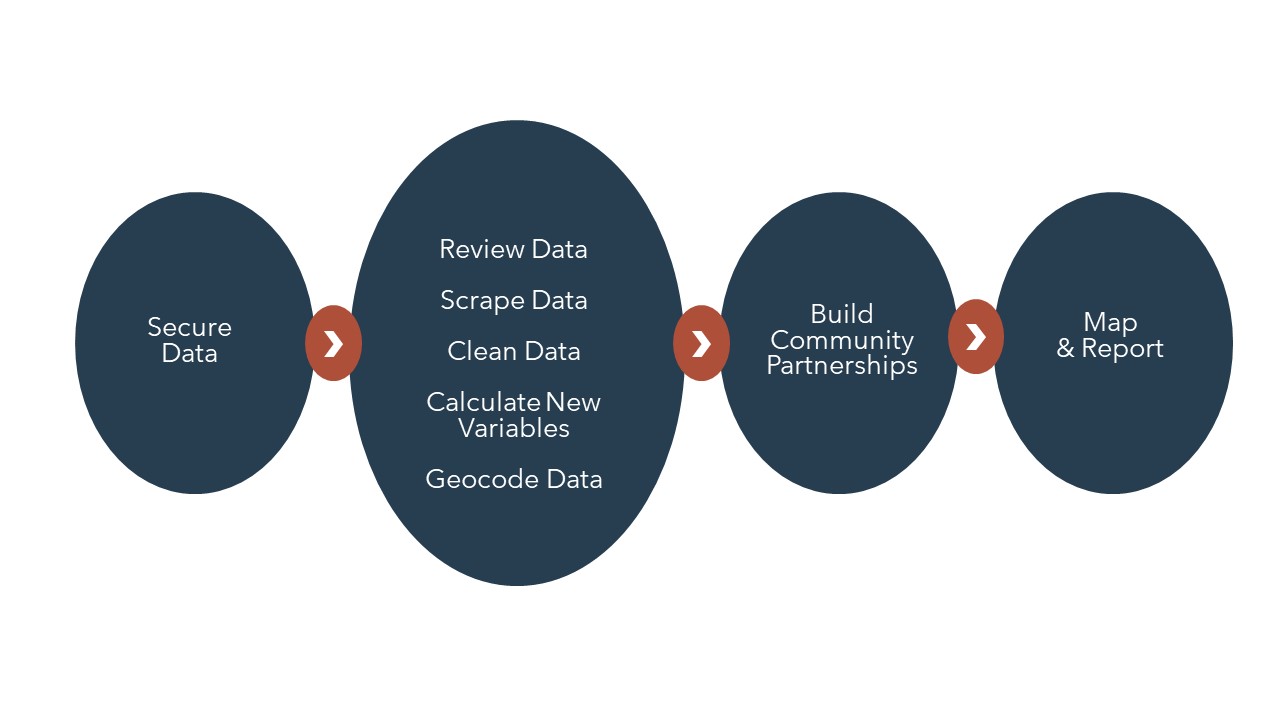Million Dollar Hoods obtains arrest and booking data through Public Records Act Requests to California Law Enforcement Agencies. Our team analyzes this data in partnership with community to document and map the human and fiscal costs of mass incarceration.

The Los Angeles Sheriff’s Department (LASD) and the Los Angeles Police Department (LAPD) are the two largest police forces in Los Angeles County. The LASD is responsible for patrolling 79% of Los Angeles County’s 4,000 square mile land base. This area, which includes contract cities and unincorporated communities as well as community colleges and the Metropolitan Transit Authority’s trains and buses, is home to about 3 million of L.A. County’s 10 million residents. The LAPD patrols just 468 square miles — amounting to less than 12% of L.A. County’s land base — but its jurisdiction, the City of Los Angeles, is home to nearly four million people. Together, LASD deputies and LAPD officers patrol 91% of L.A.’s land base, which is home to nearly 70% of the total county population.
Forty-five municipal police forces patrol the remainder of L.A. County. The Los Angeles Unified School District also maintains its own police force to patrol its K-12 school sites.
Million Dollar Hoods also does not map the cost of incarceration within the California State Prison System. If it did, the total cost of incarcerating L.A. residents would surge since Los Angeles County sends more people to state prison than any other county in the State. It costs billions to imprison the tens of thousands of L.A. residents who are incarcerated every year by the California Department of Corrections and Rehabilitation.
In March 2016, the Million Dollar Hood research team secured LAPD arrest and detention data via a California Public Records Act request. In response to that request, LAPD provided the Million Dollar Hoods research team with the following categories of information for every person arrested by a LAPD officer and detained for arraignment between January 1, 2010, and December 31, 2015: name, gender, race, and home address as well as arrest date, arrest time, arrest location, booking date, booking time, arrest charge, release date, and release time. In total, LAPD conducted 531,330 arrests/detentions in these years.
Million Dollar Hoods now receives monthly data on arrests from the LAPD.
There are several significant limitations to the data received by the team from the LAPD. First, the data does not always include the date of release for a significant number of the arrests/detentions. Without release dates, we do not know how long those people spent within the LAPD detention system prior to release or transfer. The Million Dollar Hoods team repeatedly asked the LAPD for a complete data-set or a clarification as to why so many entries are missing release dates. We received several different answers, the last of which is that the LAPD does not capture release dates for persons who are “released from custody” (RFC). However, LAPD has also informed the Million Dollar Hoods research team that persons who are “released from custody” are never actually booked at a station. Therefore, RFC is an unlikely explanation for why so many of LAPD bookings lack release and/or transfer dates.
Unable to secure more accurate release data from LAPD, the Million Dollar Hoods research team chose to assume three days to be the total period of confinement for each of the arrests with missing release dates. Why three days? According to state policy, the LAPD cannot hold people more than 96 hours (excluding holidays) within its detention facilities. After 96 hours, a person must be arraigned and, depending upon the outcome of their arraignment proceeding, released or transferred to the Los Angeles County Jail. According to the 60% of LAPD arrest data between 2012 and 2017 that includes both arrest and release dates, the average term of confinement within the LAPD detention system is 4.7 days but the median term of confinement is 2 days. Therefore, based upon an analysis of policy and data we decided 3 days of confinement to be a reasonable assumption and good-faith estimate for each of the arrests with missing release dates.
A second limitation of the LAPD data-set is that for the data with release dates, many entries are, most likely, incorrectly recorded. For example, some dates of release precede the arrest date. Other observations included release dates that far exceed the 96-hour limit. In our analysis of the LAPD data we assumed the jail days was 3 days if the release date was missing or greater than 1 month after the arrest date.
A third limitation is that once persons are transferred into the L.A. County Jail system, their term of incarceration is no longer captured in the LAPD data. In other words, the LAPD data only includes the first few days of imprisonment for persons arrested by LAPD but later transferred into the county jail. Therefore, the LAPD data only offers a peek at the total cost of incarceration for persons arrested by LAPD officers. In turn, the sums listed on the LAPD layer of the Million Dollar Hood maps are just minimum estimates for the cost of incarceration for persons arrested by LAPD officers. In many communities, the total cost is actually much higher.
And, finally, as with the LASD data, arrest charges are recorded in a multitude of ways. For example, California State Vehicle Code23152(A) (drunk driving) is recorded as follows in the LAPD data: 23152(A) VC, 23152AVC, 23152ACVC. California’s Health and Safety Code 11377 (Possession of Methamphetamine) is listed as follows: 11377H&S, 11377APC, 11377(A)HS, 11377HS, 11377(A)1HS, 11377 HS. And so on. In the map room, we listed and ranked all charges as written in LAPD data.
Daily Bed Rate
To calculate the cost to incarcerate one person for one day in the LAPD detention system, the Million Dollar Hoods research team divided LAPD’s total detention budget by the total days of incarceration in these same years. The detention budget was obtained from the Los Angeles City Controller website. Among the qualifications to this estimate is the fact that the LAPD detention line item — “custody of persons and property — combines people and things. That is, the LAPD detention budget includes the cost to house both confiscated goods and arrested persons. It is an imperfect measure of how much LAPD spends on human confinement. But the LAPD’s “custody of persons and property” line item does exclude the cost of capital improvements, which aligns with the conservative assumptions the MDH team also made for the LASD bed rate calculation.
Cost Calculation
In order to calculate the amount spent per neighborhood, we take two steps. We first multiply the cost to incarcerate a person for one day by the number of days that person spent in jail. We then add up these costs for all the arrests made of people from each neighborhood.
In October 2015, the Million Dollar Hoods research team began using the California Public Records Act to request jail data from the Los Angeles Sheriff’s Department. We requested the name, arrest date, charge, release date, and home address of every person arrested by LASD. LASD twice denied the request before approving it in January 2016.
To fulfill the team’s PRA request, LASD provided the Million Dollar Hoods research team with html downloads of all LASD booking logs. The logs capture twenty-five categories of information, including the data requested by the research team, for every person arrested by a L.A. County Sheriff’s deputy and booked into the county jail system. For more on how the Million Dollar Hoods research team scraped, cleaned, geo-coded, and mapped the LASD data.
What is important to note about the LASD booking logs is that they provide just a peek at the total cost of incarceration in the L.A. County Jail system, which is operated by the Los Angeles County Sheriff’s Department. Here are just three of the reasons why the data is limited. First, LASD booking logs only include the period of incarceration between first arrest by a LASD deputy and initial release from the county jail. If a person bails out of jail but is later convicted and returned to jail to serve time, this additional time spent in jail is not recorded in the LASD booking logs. Second, the L.A. County Jail system serves as the central jailing system within the L.A. area. The LAPD and other municipal police forces regularly book persons into the Los Angeles County jail system. Persons transferred into the LA County Jail system by these municipal police forces are not included in the LASD booking logs. Persons “re-aligned” or otherwise transferred to the L.A. County Jail system from a California State prison are also not included in the data. Third, a percentage of the entries in the LASD booking logs are missing home addresses. None of these entries could be mapped. In other words, the LASD booking logs do not allow for every person incarcerated within the county jail system nor the total number of days they spent in jail to be tallied and mapped. In turn, the sums listed on the LASD layer of the Million Dollar Hood maps are just minimum estimates for the total cost of incarceration in the L.A. County Jail system. In many communities, the cost is actually much higher.
To calculate how much LASD spent per neighborhood, the research team needed to know the home address of every person booked into jail, the total number of days of they spent incarcerated, and the average daily cost of incarceration within the L.A. County Jail system. The booking logs capture home addresses and total days incarcerated for most persons booked into the county jail system by a sheriff’s deputy. But LASD budgets do not estimate the average daily cost of incarceration. To derive a method for estimating the daily cost of incarceration across the L.A. County Jail system, the research team examined the reports that the L.A. County Auditor-Controller produced to establish the reimbursement rates that other government agencies must pay to send individuals to L.A. County Jail facilities. The Auditor-Controller splits the reimbursement cost into two parts. The first part is a one-time cost associated with “booking” an individual into jail. The second part is a daily “maintenance” cost. While the County Auditor-Controller calculations include variable costs (like staffing costs, travel and supplies), overhead costs, utilities costs, and accounting adjustments, our calculations only include variable costs. As a result, our estimates may be interpreted as conservative: they do not include costs associated with building facilities and keeping the lights on, administrating the jail system as a sub-unit of county government, providing health care, or interfacing with the law enforcement and court systems. Since reported costs vary considerably by year and by facility, we decided to use average costs across the entire inmate population for the period of the study. For both booking (B) and maintenance costs (M), we first took all relevant costs for each fiscal year prior to and overlapping with the calendar years included in the jail data (using actual costs where available and operational cost-adjustments in recent years). Then we took the average, which yielded per-inmate estimates for the daily maintenance rate (M) and for the one-time booking cost (B), averaged over the entire six years. For each neighborhood, the estimated maintenance rate (M) was multiplied by the total number of days in jail, and the estimated booking cost (B) was multiplied by the total number of bookings. The sum approximates the total cost of incarcerating the residents of an individual neighborhood.
For any additional questions about our methods, please feel free to contact our data team by emailing Info@milliondollarhoods.org
Ralph J. Bunche Center for African American Studies
Haines Hall
405 Hilgard Avenue
Los Angeles, CA 90095
bunchecenter.ucla.edu
